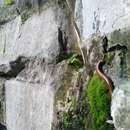Comprehensive Description
provided by Memoirs of the American Entomological Society
Spirobolus walkeri Pocock
Spirobolus zvalkeri Pocock, Ann. Nat. Hist., ser. 6, vol. 15, p. 367, figs. 14, 14b.
1895. :,
Spirobolus zvalkeri, Brolemann, Mem. Soc. Zool. France, vol. 9, p. 361. 1896. Spirobolus walkeri, Hoffman, Proc. Biol. Soc. Washington, vol. 70, p. 67, fig. 2.
1957.
Diagnosis. — Distinguished from bungii by the usually broader face, less rectangular clypeus, broader lateral ends of collum, abrupt angle of collum margin at level of eye patches, and distinct anal lips. Inasmuch as few specimens oi bungii have ever been studied and no specimens are known from the region between the type localities of bungii and walkeri, further collecting may show that these characters intergrade and that the two populations are not worthy of specific recognition. A final decision will probably have to await the apparently distant time when world politics will once again allow scientific interchange between China and other nations.
Spirobolus walkeri differs from both umbobrochus and grahami in the shape of the prefemoral process. The female cyphopod lacks the groove which is present on the cephalic side of the distal lobe in grahami; I predict that the groove will be found in umbobrochus when females are discovered. The females of walkeri lack the notch which is present in the mesal margin of the cephalic plate of the second segment of formosae.
Description.— So few specimens have been examined that values for meristic characters are given for each specimen.
L of males 94, 100, 108, 109 mm., of females 91, 111, 112, 129 mm.; W of males 7.2, 7.0, 8.0, 8.0 mm., of females 7.6, 8.0, 8.7, 9.2 mm. ; L/W of males 12.5, 13.1, 13.6, 15.4, of females 12.0, 12.0, 14.0, 14.8. Segments 54, 54, 55, 56, 58, 59,61.
Face usually broad, lateral edges of clypeus not, or only slightly, exceeded by second segment of antenna; clypeus not rectangular, the ventral corners gradually rounded; face sometimes narrower and lateral edge of clypeus farther exceeded by second segment of antenna, but clypeus never rectangular. Lateral corners of clypeus relatively distinct, antennal groove thus well-defined anteriorly ; groove not well-defined posteriorly, the parietal sclerite almost flat. Mandibular cheek only slightly grooved; stipes squared distally, with the distal margin slightly concove. Eyes per patch 42, 43, 44, 45, 46, 47, 47, 47, 48, 49, 50, 52, 54, 54, 59, 61. Clypeal setae 7, 8, 8, 8, 9, 9, 10, 12; labral setae 16, 17, 19, 22, 24, 24, 26, 27.
Paranota of collum relatively long, their ends broadly rounded or subtruncate; anterior margin of collum abruptly angled laterocauded at level of eye patches; margining ridge faint. Second segment produced below ends of collum, the production appearing as a thick, rounded knob. Cephalic plates of 2nd segment of female without deep notches in their mesal margins.
Anal valves not much compressed ; anal lips distinct but not prominent.
First and second legs shorter than other legs. Coxae of male legs 3-7 with short, distally truncate productions ; third segments of these legs slightly longer than second segments. Claws less than half length of last segments. Postgenital legs unmodified, with few ventral setae (e.g. 1-1-0-0-1-3).
Gonopods like those of bungii but mesal process of sternum longer and distally moderately broad or subacute, and prefemoral endite slightly longer with caudal side of cup slightly higher arched and distally slightly less attenuate.
Cyphopod broad distally; cephalic face of distal lobe not divided by longitudinal groove. Lateral flange narrow, its distal corner often slightly produced and tooth-like, a second tooth at about midpoint of flange, a third tooth at proximal end of flange, this often the largest; one tooth sometimes absent; second tooth sometimes slightly larger than third but then both very small.
Distribution. — ^China, Chusan Island and neighboring parts of the mainland around Ning Po.
Type. — Unknown (British Museum?). Locality: "Chusan Island " and " Da-laen-Saen, 30 miles S.W. of Ningpo, 500-2500 feet alt." Pocock did not actually designate either of these as the type locality, but the only males that he had were from Chusan Island.
Specimens Examined. — 8 (4 males, 4 females).
China. — Ningpo (1 female), McCartee (ANSP) ; Hangchovv, Sept., 1919 (3 males, 3 females), O. F. Cook, H. F. Loomis (USNM) ; Kuatum, July, 1926 (1 male). Dr. C. R. Kellogg, C. N. Pope (USNM). The last specimen has an unusually narrow face; I have unfortunately been unable to locate Kuatum to determine if it is in the area between the known ranges of zvalkeri and bungii.
- bibliographic citation
- Keeton, W.T. 1960. A Taxonomic Study of the Milliped Family Spirobolidae (Diplopoda: Spirobolida). Memoirs of the American Entomological Society vol. 17. Philadelphia, USA

